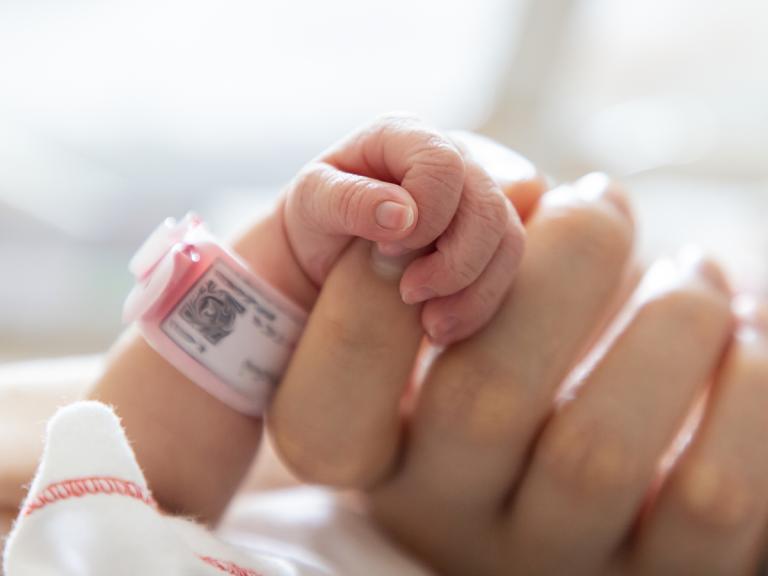
Keeping track of the key mechanisms of heat loss in newborns, as well as their primary solutions, can help clinicians maintain an environment where vulnerable infants can thrive.
Challenges to Thermoregulation in Newborns
There are several environmental challenges that can lead to infant hypothermia, not the least of which is the transition from a maternally warmed in-utero space to a cold room. This transition places the newborn at risk for four types of heat loss:
- Evaporative. A wet infant will experience evaporative heat loss quickly if not placed in an appropriate environment. Transepidermal water loss in a room lacking humidity can be significant and quickly lead to hypothermia.
- Radiant. Heat can be lost to objects in the baby's vicinity, including the walls of the room.
- Convective. Air circulation in the room can lead to heat loss as cooler air moves over the newborn's body and takes heat with it.
- Conductive. A baby placed against a cool surface will lose heat through the process of conduction.
All four pose a significant risk to a newborn's well-being. Unfortunately, heat loss is not an uncommon event. As many as 40% of infants born with a birth weight less than 1,500 g (known as very low birth weight, or VLBW) are found to be hypothermic on admission, according to the Vermont Oxford Network.1
With the risk of hypothermia comes the potential for harm. For VLBW infants, every one degree decrease below a target temperature of 36°C increases the risk of mortality by 28%, with a concomitant increase in the risk of late-onset sepsis by 11%, according to a landmark multicenter study published in Pediatrics.2
Solutions in the Delivery Room and Beyond
There are solutions to mitigate each heat loss risk. Increasing the delivery room temperature to 26°C (the ideal room temperature for newborn babies, as recommended by the Neonatal Resuscitation Program) will help to reduce radiant heat loss.
Instead of drying preterm newborns after delivery, clinicians should place infants born at less than 32 weeks in polyethylene bags to take advantage of resultant humidity and reduce convective heat loss. Chemical warming mattresses are also recommended for preterm babies, along with the use of pre-warmed beds and blankets.
In an ideal world, all of these precautions would happen every time. But when delivery occurs with little notice, or when stress levels are high, one or more of these important preventative measures may not be utilized. The result, unfortunately, is a risk of hypothermia.
Collecting data is another vital way to understand and mitigate the issues facing the babies you care for. It is imperative that all care providers at points of transition—whether it be after delivery or prior to transport—measure their infant's temperature before the transition and upon arrival at the new place of care.
Better Incubators, Better Outcomes
In order to provide the best outcomes when it comes to thermoregulation, newborns should be transported in a bed capable of addressing the four types of heat loss. Ideally, this can be accomplished with a "one baby, one bed" approach, in which an infant is cared for and transported in the same properly equipped bed. This minimizes the chance of heat loss by avoiding transfer from one bed to another.
The GE HealthCare Giraffe™ Omnibed™ Carestation, for example, provides humidity and circulated warmed air to reduce evaporative and convective heat loss. This incubator's double-walled housing with airflow helps to prevent radiant heat loss, while the warmed bedding helps to minimize conductive heat loss.
Opening the canopy of a hybrid bed for routine access to the baby is not advisable: it can cause rapid changes to heat and humidity that can have a recessive effect on the infant's thermal status. This is especially true for infants of less than 29 weeks. Raising the canopy of a hybrid bed should be considered for situations where the risks of thermal instability from a rapid temperature change are outweighed by the benefits of opening the bed, i.e., a code or complex procedure.
A study examining the use of the Giraffe OmniBed carestation over the first 24 hours of life for infants born at a mean gestational age of 29 weeks and 1,505 g found that the bed was opened an average of 2.85 times per day for 12 minutes at a time. During these periods, there were no differences noted in mean skin temperature, heart rate, respiratory rate, mean blood pressure, or oxygen saturation. This was true whether the bed was in open mode (radiant warmer) or closed mode (incubator), and during transitions from one stage to the other.
The Giraffe OmniBed carestation is also compatible with powered transport, such as the GE HealthCare Giraffe Shuttle, another key tool for addressing thermoregulation in preterm infants. In a separate study of very low birth weight infants (less than 1,000 g) published in Pediatrics, this combination was found to improve admission temperatures by 0.49°C compared to conventional transport incubators.3
Thermoregulation is a critical part of optimal care for newborns. When equipped with the right tools, the team can be better prepared and effectively minimize risk. Every degree matters—and the use of a "one baby, one bed" approach to care helps ensure newborns stay warm along their journey.
References:
- Vermont Oxford Network. Despite decreases, nearly 4 in 10 infants are cold when admitted to the NICU. https://public.vtoxford.org/nicu-by-the-numbers/despite-decreases-nearly-4-in-10-infants-are-cold-when-admitted-to-the-nicu/. Accessed October 19, 2022.
- Laptook AR, Salhab W, Bhaskar B, et al. Admission temperature of low birth weight infants: predictors and associated morbidities." Pediatrics. 2007;119(3):e643-e649. doi:10.1542/peds.2006-0943
- Kim SM, Lee EY, Chen J, et al. Improved care and growth outcomes by using hybrid humidified incubators in very preterm infants. Pediatrics. 2010;125(1):137-145. doi:10.1542/peds.2008-2997








